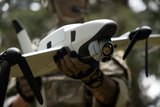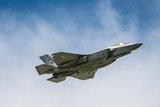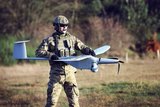RAF leads the way to a green future
The first aircraft powered by synthetic fuel was achieved by the Royal Air Force and Zero Petroleum Limited in Kemble, Cirencester, UK, on 2 November 2021. (Photo: Zero Petroleum)
The Chief of the Air Staff, Sir Mike Wigston, spoke on 23 November about the RAF’s ambitious plan to achieve net-zero emissions by 2040.
It is appropriate that the RAF is leading the way to carbon neutrality, he said, as the service is responsible for around half of the MoD’s carbon footprint.
The first milestone will be developing RAF Leeming into a carbon-neutral airbase by 2025, the lessons learned will then be implemented across other bases.
However, the largest contributor to the RAF’s high level of emissions is the fuel used to fly. Wigston noted that aviation kerosene accounts for three-quarters of the RAF’s carbon footprint.
Advancements are being made to move away from reliance on kerosene. Many platforms now operate a 50/50 blend of synthetic fuels and kerosene. Moreover, the world’s first successful flight fuelled entirely by synthetic fuels occurred last week, Wigston said.
He added that the first zero-emission aircraft is expected by the end of the decade, which is likely to be a training aircraft.
Therein lies the problem, Wigston added; while synthetic fuels may be used on training aircraft, the technology is not advanced enough to power the next generation of combat aircraft.
There is much work to do, as he explained: ‘It will take decades, and I tell my next generation of leaders that it will largely fall to them to deliver’.
More from Air Warfare
-
![December Drone Digest: Germany, Australia and US champion indigenous UAV production]()
December Drone Digest: Germany, Australia and US champion indigenous UAV production
One of the key trends seen in December has been the rise in indigenous investment within the UAV market, particularly across certain countries, with Germany, Australia and the US focusing on their commitments to sovereign development.
-
![What might next-generation military aircrew training look like?]()
What might next-generation military aircrew training look like?
Changing roles for combat aircraft fleets, the rise of simulation and LVC technologies, and the increasing cost of flight hours could all be leading to a paradigm shift in military pilot training.
-
![2025 air market review: European defence independence, next-gen tech and export concerns dominate]()
2025 air market review: European defence independence, next-gen tech and export concerns dominate
This year’s (geo)political turmoil has challenged many long-prevailing assumptions, leading to far-reaching consequences for air forces and their supplier bases in industry worldwide – with five key trends in review for 2025.
-
![Poland air report: Drones, transport aircraft and tankers dominate potential procurement plans]()
Poland air report: Drones, transport aircraft and tankers dominate potential procurement plans
With a rising defence budget and equipment list, Poland’s air market is set to grow as the country continues to modernise its transport and helicopter fleets while seeking out uncrewed aerial vehicles and loitering munitions.
-
![Portugal signals interest in establishing A-29N final assembly line]()
Portugal signals interest in establishing A-29N final assembly line
As the launch customer for the NATO-configured variant, Portugal also took delivery of the first five A-29N aircraft from its order for 12, placed in 2024.
-
![Podcast: Critical Care episode 5 - Sustaining Europe’s frontline from Heidelberg]()
Podcast: Critical Care episode 5 - Sustaining Europe’s frontline from Heidelberg
As Europe ramps up defence investment in the wake of the Ukraine crisis, the spotlight is turning to how nations sustain their growing fleets.

























